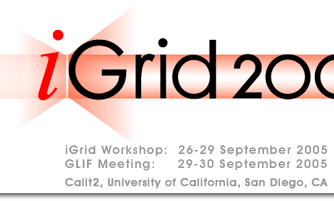News Releases
Netherlands’ High-Performance Computing and Networking Center SARA to Demonstrate Unique Transatlantic Visualization at iGrid2005
San Diego and Amsterdam, September 25, 2005 - Scientists from the Netherlands will attempt to establish a new world record by generating the largest real-time data stream to date for ultra-high-resolution visualization. The Dutch high-performance computing and networking center SARA Computing and Networking Services will attempt the record at iGrid 2005, the biennial international network event Sept. 26-29 in San Diego, California.
“This is a unique event,” said SARA Division Manager for High-Performance Networking Paul Wielinga. “Our success can only be realized by making use of the combination of the fastest virtual graphic card, the fastest network, the fastest transatlantic connection, and the largest display.”
The 2-D and 3-D data objects of Netherlands’ scientists will be rendered live on a powerful visualization cluster in Amsterdam (the Netherlands). The rendered images are transported as a pixel stream via optical lambda networks to San Diego, using a network bandwidth of 20 Gigabits per second (Gbps). In San Diego SARA will be displaying the output on the EVL LambdaVision Display of 55 screens (11 horizontally x 5 vertically) resulting in a total resolution of 17,600 x 6,000 pixels (in total 105,600,000 pixels).
The infrastructure between Amsterdam and San Diego consists of a 20 Gbps connection that has been set up in close cooperation with SURFnet, the Netherlands’ National Research and Education Network (NREN). The connection between Amsterdam and Chicago is realized through NetherLight, the optical exchange for research networks, and its sister facility StarLight in Chicago. The NRENs in the USA provide the connectivity between Chicago and San Diego. This technique is part of the OptIPuter, a U.S. National Science Foundation-funded project led by the University of California, San Diego and University of Illinois at Chicago, in which SARA actively participates.
OptIPuter is a very powerful distributed cyber infrastructure to support data-intensive scientific research and collaboration. Network-intensive visualization techniques on all kinds of output systems, such as high-definition stereoscopic displays, ultra-high-resolution tiled displays and personal auto-stereoscopic displays, are an important field of interest for SARA. SARA has developed a new advanced system for scalable and distributed visualization of ultra-high-resolution 2-D and 3-D data objects. Within the framework of OptIPuter, SARA has contributed to the development of the Global Lambda Visualization Facility (GLVF) and Technology for Optical Pixel Streaming (TOPS), which are both related to the worldwide visualization facility that is being developed.
About SARA
SARA Computing and Networking Services is an advanced ICT service center that supplies - since more than 30 years - a complete package of high-performance computing, storage, visualization, networking, and infrastructure services. Among SARA’s customers are the business community and scientific, educational, and government institutions. SARA is an independent organization with offices in Amsterdam and Almere, and collaborations with many partners.
The most eye-catching activities and facilities of SARA are the national Supercomputers, the Amsterdam Internet Exchange (AMS-IX), and the Virtual Reality facility, the CAVE™. Since the start of the SURFnet network in 1989, SARA is responsible for the operational management of this academic high-bandwidth network for Netherlands universities, research centers and educational institutions. An important addition to the available facilities is SARA’s thorough expertise and the resulting consultancy and support activities. More information about SARA can be found at: www.sara.nl
About iGrid 2005
The International Grid (iGrid) collaborative event showcases ongoing global collaborations in middleware development and applications research that require high-performance multi-gigabit networks. The iGrids are organized every two or three years by institutions, organizations, consortia and National Research & Education Networks who also participate in the Global Lambda Integrated Facility (GLIF). Overall planning responsibilities for iGrid 2005 are being handled by the Electronic Visualization Laboratory at the University of Illinois at Chicago and the California Institute for Telecommunications and Information Technology (Calit2) at the University of California, San Diego, in cooperation with the Mathematics and Computer Science Division of Argonne National Laboratory, SURFnet, University of Amsterdam, and CANARIE. For more information, see www.igrid2005.org.
For the Media:
For more information on SARA’s challenge at iGrid2005, you can contact Paul Wielinga (wielinga @ sara.nl) or Bram Stolk (bram @ sara.nl) of SARA Computing and Networking Services, Amsterdam, the Netherlands. Paul Wielinga and Bram Stolk will both be present at iGrid2005.
Related Links:
SARA www.sara.nl
iGrid2005: www.igrid2005.org
OptIPuter: www.optiputer.net
GLVF: www.evl.uic.edu/cavern/glvf
TOPS: www.sara.nl/tops


